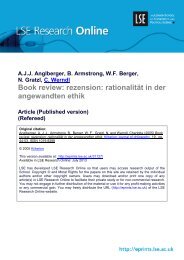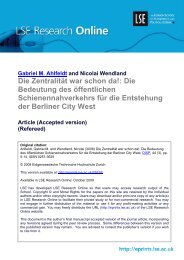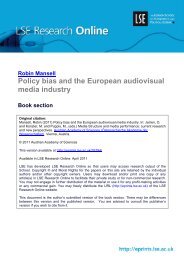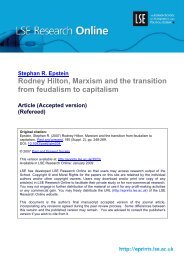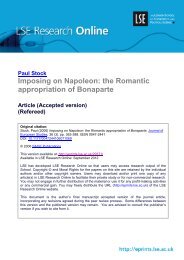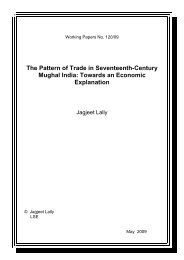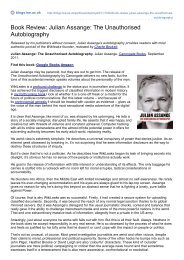Download (535Kb) - LSE Research Online - London School of ...
Download (535Kb) - LSE Research Online - London School of ...
Download (535Kb) - LSE Research Online - London School of ...
You also want an ePaper? Increase the reach of your titles
YUMPU automatically turns print PDFs into web optimized ePapers that Google loves.
3 Empirical expansions and bias correction<br />
The present section develops our results to provide feasible improved statistical inference on 0. An<br />
approximate 100 % con dence interval for 0 based on the CLT isgiven by<br />
(bh ; z =2m ;1=2 bh + z =2m ;1=2 ) (3.1)<br />
where 1 ; (z )= . From (2.23) a more accurate con dence interval is<br />
(bh + 3qmm ;1=2 + p(z =2)m ;1 ; z =2m ;1=2 bh + 3qmm ;1=2 + p(z =2)m ;1 + z =2m ;1=2 ): (3.2)<br />
Of course (3.1) and (3.2) correspond to level- hypothesis tests on 0. We reject the null hypothesis<br />
0 = 0<br />
0, for given 0<br />
0 (e.g. 0<br />
0 = 0, corresponding to a test <strong>of</strong> short memory) if 0<br />
0 falls outside (3.1)<br />
or, more accurately, (3.2).<br />
An obvious aw in the preceding discussion is that 3 is unknown in practice. However, given<br />
an estimate b 3 such that<br />
b 3 ! 3 a.s (3.3)<br />
we deduce from (2.13) the empirical Edgeworth expansion<br />
sup P fU<br />
y2R<br />
h m yg; (y) ; (y)(b3qm + m ;1=2 p(y)) = o(qm + m ;1=2 ) a:s: (3.4)<br />
We can likewise replace 3 by b3 in (2.15), (2.19), (2.21), (2.23) and (3.2).<br />
We discuss two alternative estimates <strong>of</strong> 3. Our rst is<br />
b31 =( n<br />
m0 ) R(1)<br />
m0 (bh) (3.5)<br />
where<br />
in which<br />
and<br />
1<br />
Skm0( )=<br />
c0m0 R (1)<br />
0( )<br />
0 m ( )=S1m (3.6)<br />
S0m0( )<br />
m 0<br />
X<br />
j=l<br />
jm0 =logj ; (m0 ; l +1) ;1<br />
m 0<br />
k<br />
jm 0 3j Ih( 3j) k 0 (3.7)<br />
X<br />
j=l<br />
log j (3.8)<br />
where m 0 is another bandwidth, increasing faster than m. Note that R (1)<br />
m ( )=(d=d )Rm( ) (see<br />
(2.4)), and so R (1)<br />
m (bh) =0. Our second estimate <strong>of</strong> 3 is<br />
b32 = bc1 3<br />
( ) (3.9)<br />
bc0 ( +1) 2 2<br />
where, as in Henry and Robinson (1996), bc0 and bc1 are given by least squares regression based on<br />
(2.6), i.e.<br />
bc0<br />
bc1<br />
=<br />
2<br />
4 m0<br />
X<br />
j=l<br />
1 3j<br />
3j<br />
2<br />
3j<br />
!3;1<br />
0<br />
Xm<br />
5<br />
j=l<br />
1<br />
3j<br />
b h<br />
3j Ih( 3j): (3.10)<br />
Estimation <strong>of</strong> 1 is relevant in connection with (2.16). We de ne b 11 by replacing 3j by 1j,<br />
Ih by I and 3 by 1 in (3.7), and then bh by b in (3.5). Likewise we can de ne b 12 by (3.9) with 3<br />
replaced by 1in(3.9)and3 3jIh and bh by 1 jI and b in (3.10).<br />
9





